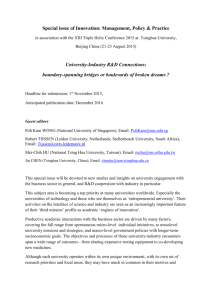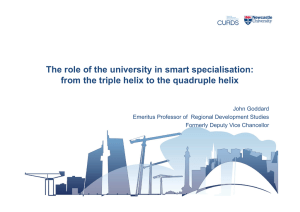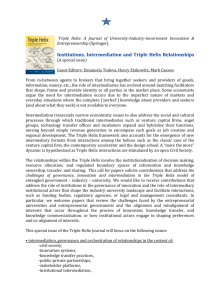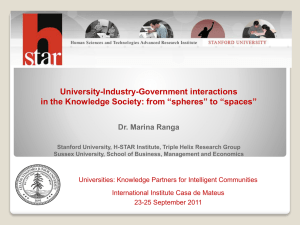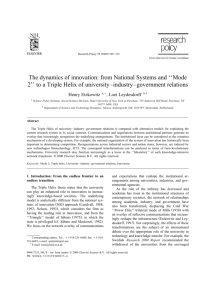The Triple Helix model: a Tool for the Study of European Regional
advertisement
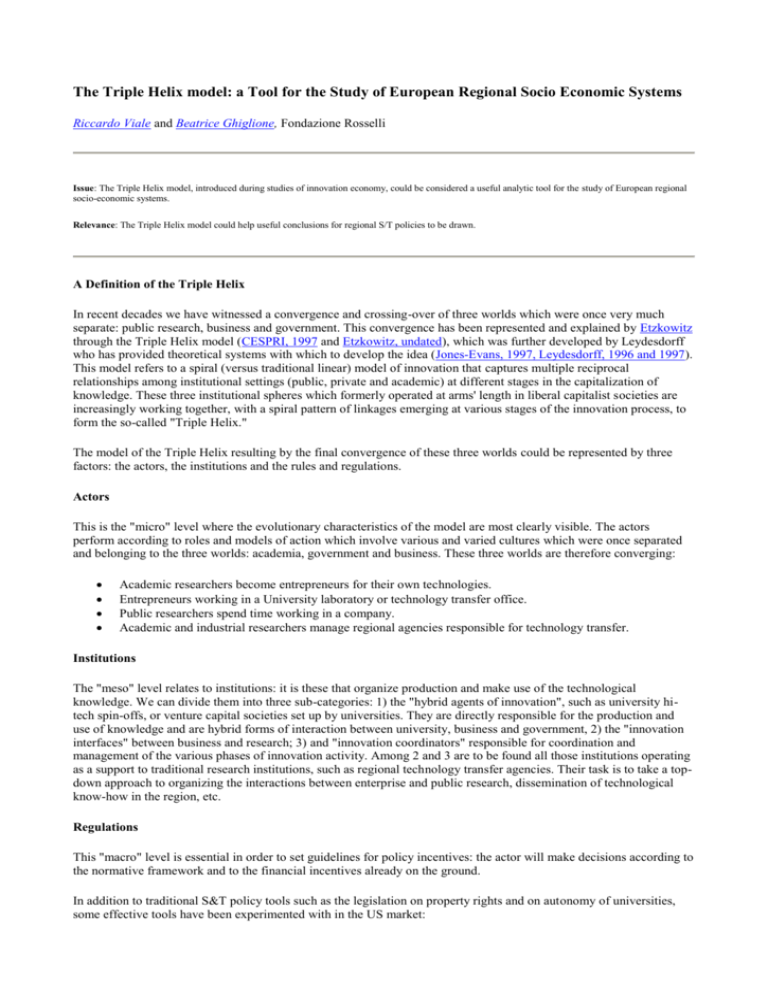
The Triple Helix model: a Tool for the Study of European Regional Socio Economic Systems Riccardo Viale and Beatrice Ghiglione, Fondazione Rosselli Issue: The Triple Helix model, introduced during studies of innovation economy, could be considered a useful analytic tool for the study of European regional socio-economic systems. Relevance: The Triple Helix model could help useful conclusions for regional S/T policies to be drawn. A Definition of the Triple Helix In recent decades we have witnessed a convergence and crossing-over of three worlds which were once very much separate: public research, business and government. This convergence has been represented and explained by Etzkowitz through the Triple Helix model (CESPRI, 1997 and Etzkowitz, undated), which was further developed by Leydesdorff who has provided theoretical systems with which to develop the idea (Jones-Evans, 1997, Leydesdorff, 1996 and 1997). This model refers to a spiral (versus traditional linear) model of innovation that captures multiple reciprocal relationships among institutional settings (public, private and academic) at different stages in the capitalization of knowledge. These three institutional spheres which formerly operated at arms' length in liberal capitalist societies are increasingly working together, with a spiral pattern of linkages emerging at various stages of the innovation process, to form the so-called "Triple Helix." The model of the Triple Helix resulting by the final convergence of these three worlds could be represented by three factors: the actors, the institutions and the rules and regulations. Actors This is the "micro" level where the evolutionary characteristics of the model are most clearly visible. The actors perform according to roles and models of action which involve various and varied cultures which were once separated and belonging to the three worlds: academia, government and business. These three worlds are therefore converging: Academic researchers become entrepreneurs for their own technologies. Entrepreneurs working in a University laboratory or technology transfer office. Public researchers spend time working in a company. Academic and industrial researchers manage regional agencies responsible for technology transfer. Institutions The "meso" level relates to institutions: it is these that organize production and make use of the technological knowledge. We can divide them into three sub-categories: 1) the "hybrid agents of innovation", such as university hitech spin-offs, or venture capital societies set up by universities. They are directly responsible for the production and use of knowledge and are hybrid forms of interaction between university, business and government, 2) the "innovation interfaces" between business and research; 3) and "innovation coordinators" responsible for coordination and management of the various phases of innovation activity. Among 2 and 3 are to be found all those institutions operating as a support to traditional research institutions, such as regional technology transfer agencies. Their task is to take a topdown approach to organizing the interactions between enterprise and public research, dissemination of technological know-how in the region, etc. Regulations This "macro" level is essential in order to set guidelines for policy incentives: the actor will make decisions according to the normative framework and to the financial incentives already on the ground. In addition to traditional S&T policy tools such as the legislation on property rights and on autonomy of universities, some effective tools have been experimented with in the US market: laws supporting "venture capital activities" for hi-tech businesses. NASDAQ, a Stock Exchange helping, among others, high-tech businesses. Neo-Corporatist or Evolutionary Triple Helix? The model described above is a prescriptive answer to the problems of competition and knowledge generation. However, it is also an empirical description of what is happening in various parts of the industrialized world. There are however two different interpretations of the Triple Helix model: the neo-corporatist interpretation is focussed on reaching a consensus on activities among the representatives of academia, industry and government and with the involvement of "innovation coordinators". The coordination committees plan the integration process and there is no belief in the possibility of an endogenous evolution. These committees set up the institutions able to increase the technological output according to a top-down model. A European regional S&T policy example is the constitution of regional technology transfer agencies in Lombardy, Italy. According to CESPRI (Campodall’Orto), in fact, 91.1% of innovative firms in Lombardy have never had contact with these centres, whereas they have frequent, direct and cooperative contacts with universities following a bottom-up technology transfer approach. Among the technology transfer centres set up in Lombardy, CESTEC is the most typical example of a top-down neo-corporatist approach: the technology transfer agency was set up by a public-private initiative but it gradually became a technical support agency for regional initiatives and it has lost its primary role as an agent for technology transfer. The neocorporatist model is however not satisfactory in terms of the level of integration among actors, and it rarely results in innovation-related business start-ups and has a generally low technological output. The most effective answer lies in the legislative measures supporting a bottom-up approach involving all actors. In fact no coordination or planning committee, as proved by many experiments in this field, has enough knowledge or information which is typical of the interaction among various socio-economic actors. Therefore the neocorporatist model implying coordination committees is, usually, a weak defensive answer to the difficulties of the innovation context to find integration opportunities in order to increase technology production. The neo-corporatist model stands opposite an evolutionary Triple Helix model where the government role is limited but more crucial. In fact it has to define the normative framework appropriate for the planning of individual incentives for reorienting academic and industrial actors towards a higher level of integration. According to experience from the USA and some EU countries it seems that it is possible to obtain in terms of technological innovation, from the spontaneous convergence of industrial and academic world. The evolutionary interpretation of the Triple Helix model assumes that within specific local contexts universities, government and industry are learning to encourage economic growth through the development of what has been called "generative relationships" (Leydesdorff & Etzkowitz, 1997) i.e. loosely coupled reciprocal relations and joint undertakings that persist over time and induce changes in the way agents come to conceive their environment and how to act in it. As far as European countries and regions are concerned, and according to the evolutionary interpretation of the Triple Helix model, it is therefore important to stress the role universities can play as promoters of socio-economic development (Fondazione Rosselli, 1995), especially in the context of peripheral regions that are not currently recognized as technologically dynamic. In these areas the productive system is based largely on traditionally run SMEs combined with a lack of R&D investment and the weakness of the institutional support system. The evolutionary triple helix model suggests that there is a potential for knowledge-based development in these regions stressing the role that universities can play as a factor for socio-economic development within a spiral trilateral interaction between academia, industry and government. In Ireland, for example, Trinity College University in Dublin set up the Innovation Centre around ten years ago with the specific aim of hosting companies, industrial laboratories and, most of all, to help some academic teachers to become entrepreneurs. Since then, various international campus companies have been set up and are being run by academics; international corporations have been attracted to Trinity College and have set up laboratories which share university human resources and technological equipment and which attract the best university researchers; the government as well has set up public laboratories and research centres aiming to let them interact with the enterprises present there (Gebhart, 1996). Neo-Corporatist versus Evolutionary Triple Helix: The results of the analysis of some Regional European Innovation Systems The following analysis of concrete regional case studies shows the relevance of the Triple Helix model for the analysis and implementation of regional innovation policies. Though technologically very strong relative to other parts of Italy, Lombardy (Campodall’Orto, 1997; Etzkowitz, 1997; Lane, 1991) is a long way behind other industrialized regions of the world. The presence of regional technology transfer agencies has not supported successful technology transfer experiences, as mentioned above and therefore companies tend to establish direct contacts with universities, above all the Politecnico di Milano. This reveals the public agencies’ shortcomings in promoting technology transfer to business. As for universities and research centres in Lombardy, they rarely play the role of setting up "hybrid agents of innovation", such as Science Parks. The only successful technology transfer example is the Photonic Research Centre at the Politecnico di Milano, funded by Pirelli, which implies spontaneous convergence of industry and academia and has met with approval and incentives from local government (Teknova, 1995). Notwithstanding this and a few other examples, the Lombardy universities are far from the University model as an economic actor in the technology market. In terms of innovation output from businesses, 92.5% of patents are produced by private research centres, of which 84% are produced by multinationals (Assolombarda, 1994). Last but not least, technology policy concentrates on the national level and only three regional laws for innovation financing have been introduced. They have partially failed as a result of the lack of a serious technology foresight study. In Catalonia, Spain, S&T policy over the last decade has been considerably more innovative than at any previous time. This period has been marked by a significant increase in public and private S&T funding, which translated into a considerable increase in S&T spending, human resources and infrastructure. S&T policy in some way reflects, however, a more typical top-down approach: it has led to the creation of a neo-corporationist-type triple helix of academia, government and industry relations. That is to say the relation has emerged as a consequence of the role of the state has aiming more to finance technology programmes which are being produced by the national or Catalan governments and public research structures, rather than set incentives for spontaneous university-industry relations and related technology transfer processes. In order to maintain the spirit of innovation it is therefore necessary to solve some problems in the process of technology transfer from university to industry. Nevertheless an example of a successful attempt at university-industry collaboration is given by the Barcelona Science Park (Bellavista, undated) which describes an evolution towards more dynamic university models. This Science Park seems to take into account the need for universities to be well connected with the economic and social world as their main target. The location of the Science Park in the Pedralbes Area responds to the existing availability of research potential in that area which is where the University of Barcelona locates its most active research personnel and most important research infrastructures and services. The same can be observed in the Catalonia Polytechnic University and in the CSIC Institutes in Barcelona. The high standard location is used as a factor in attracting investment to the area. In fact the concentration of research potential is unique in the geography of Catalonia and it may be considered an important added value for the development of research, innovation and technology transfer processes. Trilateral relationships have developed: the University provided the site, the Catalonian Autonomous Government and the Spanish Government have supported the project economically and politically since its inception. The Catalonia Savings Bank regional development funds from EU have also supported the initiative. An evolutionary interpretation of the triple helix has taken place since the relationships among actors have shaped according to a networks innovation model (Campodall’Orto, 1997) where sharing information, knowledge and experience are given high priority. Within the Barcelona Science Park project the virtuous cycle of academia-government-industry relations has been translated into an integration system that involves universities, research institutes, governments, private companies, research personnel and infrastructures. In this respect the Barcelona Science Park and the Photonic Centre at Politecnico di Milano are two promising examples of a new evolutionary triple-helix approach. These two regional case studies suggest that the Triple Helix model can be applicable to the analysis of regional S&T policies in Europe. Keywords Triple Helix, neo-corporatist, evolutionary, knowledge society, innovation system, S&T policy References Assolombarda, Ricerca ed innovazione tecnologica: analisi del fabbisogno delle aziende, Milano, 1994. Bellavista, J., The Barcelona Science Park: a triple helix model in the Catalan and Spanish Research System, in Etzkowitz H., Leydesdorff H., A Triple Helix of University-Industry-Government relations. The future location of Research. Campodall’Orto, S., Ghiglione, B., The Technology Transfer Process within the New Innovation Models, in Managing Technological Knowledge Transfer, EC-Social Sciences COST A3, vol. 4, EC Directorate General, Science, research and Development, Bruxelles, 1997. CESPRI, Cambiamenti nella struttura industriale lombarda e politiche regionali per l’innovazione tecnologica, Rapporto di ricerca, University Bocconi, Milan, 1997. Etzkowitz, H., Academic-Industry Relations: A Sociological Paradigm for Economic Development, in Leydesdorff, H., Van den Besselaar, P., (Eds.), Evolutionary Economics and Chaos Theory: New directions in technology studies. Etzkowitz, H., The Triple Helix: academy-industry-governement relations and the growth of neo-corporatist industrial policy in the U.S., in S. Campodall’Orto (ed.), Managing Technological Knowledge Transfer, EC Social Sciences COST A3, Vol. 4, EC Directorate General, Science, Research and Development, Brussels, 1997. Fondazione Rosselli-CES&T, Analysis of the regional science & technology policies in Europe, (CE-DG XII, Grant Contract: PSS*0819), Fondazione Rosselli Scientific Report, 23, 1995. Gebhardt, C., Etzkowitz, H., Regional innovation Organiser: a quasi-public role for transational corporations and universities, in Management and New Technology, COST A3, Madrid, 1996. Jones-Evans, D., Entrepreneurial Universities - Cases of Good Practices from the Republic of Ireland, International Conference: Technology Policy and Less Developed Research and Development Systems in Europe, UNU-INTECH, International Conference, Seville, 18-20 October 1997. Leydesdorff, H., Van den Besselaar, P., (Eds.), Evolutionary Economics and Chaos Theory: New directions in technology studies, Pinter, London, 1994. Leydesdorff, H., Etzkowitz, H., Emergence of a Triple Helix of University-Industry-Government Relations, Science and Public Policy, 1996. Leydesdorff, H., Etzkowitz H., (Eds.), A triple Helix of University-Industry-Government relations. The future location of Research, Book of Abstracts, Science Policy Institute, State University of New York, 1997. Lane, D., Malerba, F., Maxfield, R., Orsenigo, L., Choice and Action, Journal of Evolutionary Economics, 1991. Teknova, Sistema di monitoraggio della ricerca scientifica e dellíinnovazione tecnologica in Lombardia, Ricerca IRER cod. 93.64, Milano, 1995. Viale, R., Tripla elica in Lombardia: evoluzione nel raccordo tra ricerca, impresa e governo, in Conferenza Regionale della Lombardia - Scenari dello Sviluppo, Milano, 4 Marzo 1998. Contacts Riccardo Viale and Beatrice Ghiglione, Fondazione Rosselli Tel: +39 011 562 25 10, fax: +39 011 561 17 48, e-mail: fondazione.rosselli@iol.it About the authors Riccardo Viale holds the chair of Methodology of Social Sciences at the Faculty of Political Sciences of the University of Milan, is professor of Philosophy of Science for the Economic and Social Disciplines Course at the University "Luigi Bocconi", Milan. He is also a visiting lecturer at the Rice University of Houston (199899). His main areas of research interest include: Methodology of Social Sciences, Philosophy of Science, Cognitive Theory of Decision-Making, Theory of Social Action, Sociology of Science, Science and Technology Policy, Metrics of Science and Technology. Beatrice Ghiglione holds a degree in Philosophy from Catholic University of Milan and a post-graduate Master Degree in Managerial decision-making and public ethics. She is a researcher at Fondazione Rosselli and she is in charge of the technical co-ordination of CeS&T - Centre of Science and Technology Policy at Fondazione Rosselli. Her main areas of research interest include: Technological innovation (S&T Policies, Technology Transfer, History of Technological Innovation); Multimedia and Training (Social and Organisational Impact of Multimedia on New Job Profiles, Telework, Digital Libraries, Distance Learning).


